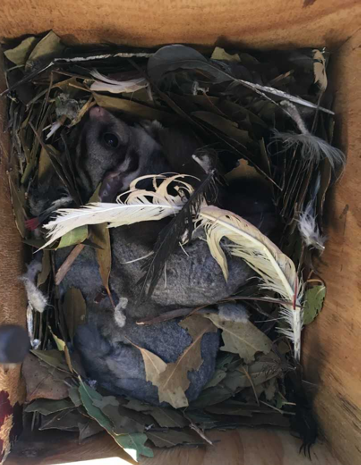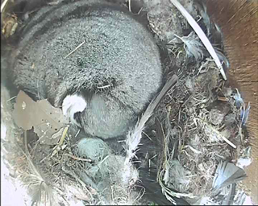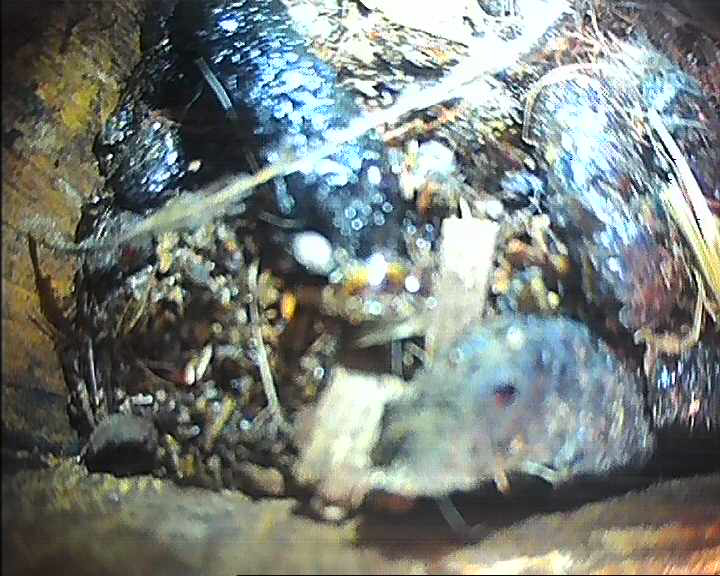What’s in that nest box? – an update on our monitoring program
Posted on 9 July, 2020 by Jess
Connecting Country’s ten years of nest box monitoring
One way that Connecting Country contributes to nature conservation in the Mount Alexander region is through our nest box monitoring program. We set up this program in 2010 to monitor our favorite hollow-dependent marsupial: the Brush-tailed Phascogale. This adorable little animal has experienced a serious range contraction and decline in numbers across Victoria. However, the Mount Alexander region remains a stronghold for this special critter.
Our 450 nest boxes across the region help us to provide homes where natural nesting hollows are rare. They also allow us to monitor this species population through time and learn more about its habitat requirements, and provide a great opportunity for landholders and volunteers to engage with a rarely-seen animal and learn more about wildlife on their properties. This project has also contributed valuable information to the Victorian Biodiversity Atlas, an Arthur Rylah Institute investigation into nest box use in Victoria, and a PhD project at La Trobe University.
Life in a sharehouse
Our nest boxes are designed for phascogales, but they are also used by sugar gliders. The two species and their nests are easy to tell apart if you can get a really good look at them. Phascogales have a characteristic black brushy tail. They make messy, smelly nests with shredded bark, leaves, feathers, and fur, and leave scats in the nest. Sugar gliders have a rounder muzzle, a gliding membrane, a tapered grey and black tail (often with a white tip), and extra-cute big round eyes. They make neat nests of fresh eucalyptus leaves in a cup shape. Below, we have two phascogales in typical phascogale nests, and two sugar gliders in typical sugar glider nests.
To learn as much as we can about who’s been using a nest box, it’s important to take a really careful look and document what we see. It’s not always simple! Below, we have a sugar glider in a phascogale nest (left), and a phascogale in a sugar glider nest (right).
Checking nest boxes
Our nest boxes are usually installed on trees that don’t already have natural hollows, on tree species that have rough bark (so it’s easier for animals to climb to access the nest box), and face south-south-east so the boxes don’t get too hot in summer. They are usually installed about 3 m high above the ground to help keep our precious native animals safe from predators such as foxes, and keep our nest boxes safe from vandalism.
This brush-tailed phascogale was climbing a grey box tree to get to its Connecting Country nest box. Photo: Jess Lawton (La Trobe University)
However, this also presents some logistical and safety challenges. We’ve always checked out nest boxes by climbing a ladder and carefully opening the lid of the nest box to inspect and photograph contents (without flash). Climbing a ladder brings a safety risk, and we are always looking for ways to make things safer for our staff and volunteers.
Over the last two years we’ve been reviewing our monitoring program as part of our Habitat Health Check project, supported by Helen Macpherson Smith Trust. We’ve done this to ensure our program is robust, and our volunteers are trained and safe. As part of this process we decided to trial a new way of inspecting nest boxes, checking them from the ground using a nest box inspection camera – an endoscope-type camera on the end of a long pole. We wanted to find out if the inspection camera made nest box checks safer and more efficient. We also wanted to test if we got the same results during our nest box checks if we used this new inspection method.
A new way forward?
So, in early 2020, armed with the best nest box inspection camera we could get our hands on, we trialed both survey methods. Asha, Jess, and intrepid volunteers Alex and Trevor, checked 17 nest boxes across two properties in Sutton Grange with both survey methods: an inspection camera, and by climbing a ladder and carefully peeking inside. We divided into two teams and went our separate ways to check the nest boxes, so no-one could guess what was in a nest box by looking at the other team’s excited facial expressions!
Below, you can see what each team saw at three nest boxes with both inspection methods. The inspection camera on the left, and by climbing a ladder and peeking inside on the right.
Can you guess which nest box inspection method we prefer? The two teams got different results at 5 out of the 17 nest boxes we inspected (that’s 29% of nest boxes!). For one nest box, this was because of different understandings of what the different species nest’s look like, which highlights the need for comprehensive training for all our inspectors. However, the remaining differences in nest box results between the two methods were because it was difficult to get a good enough look inside the nest boxes with an inspection camera. Overall, the ladder inspection method gave us a more accurate picture of what was going on in the nest boxes.
We also learnt that using an inspection camera for our particular type of nest boxes was not necessarily faster because the nest box lids were tricky to open using a pole from the ground. Surprisingly, inspecting nest boxes by climbing a ladder seemed less disruptive to the animals, as it was faster and quieter to open the nest box lid from a ladder.
We don’t want to change monitoring method if this will make our results less accurate. If we change our ability to detect animals, we can’t tell if changes in recorded animals are because of real population changes, or because of a change in our monitoring method. Instead, our plan for the future is to improve our ladder safety procedures, equipment and training for our nest box inspectors. The inspection cameras will still be valuable as a community engagement tool and backup method.
We will closely monitor COVID-19 restrictions with the hope of monitoring our nest boxes again in Autumn 2021. We think seeing a wild phascogale in a nest box is a very special experience. Please contact Jess Lawton if you would like to be added to our volunteer list (jess@connectingcountry.org.au). Volunteers must have a reasonable level of fitness and be comfortable working in the bush. We will need some volunteers to climb ladders (training provided), and some volunteers to carry equipment and take notes with feet planted firmly on the ground.
Connecting Country wishes to acknowledge the invaluable current and past support for our nest box program provided by Helen Macpherson Smith Trust, Wettenhall Environment Trust and Bank Australia.





















Hello I have been searching online for an easy way to see into my nesting boxes when I came across your article. I have a grey-shrike-thrush box which is occasionally camped in (crampedly) by a what I thought might be a sugar glider but your pictures make me think it’s a phascogale as there is often a fluffy black tail hanging out the opening. Now I can check the nest when it’s empty and know for sure. thanks.
Hi Caroline,
Thanks for your comment – I’m glad you found this useful!
Cheers
Jess
Howdy Jess. I think you can use the cameras in conjunction with the ladder. I have 200 nest boxes at Crusoe and many are easy to Identify contents with the camera, without having to scale the ladder and look in. They are empty or have one animal in them. I find it heaps quicker just to poke the camera in , have a look and move to the next if it is empty or easy to Id. Any that I’m unsure of I will use a ladder to clarify. Cheers Blair
Hi Blair, Thanks for your comment. Yes, this approach would work with the newer style nest boxes that have an entrance on the side of the nest box because it’s easy to poke a camera in the entrance hole. Our nest boxes are an older style and have the entrance for the animals on the panel of the nest box directly adjacent to the tree trunk (see photos), and we are not able to fit the camera in through the entrance hole to get a look because the tree trunk is in the way. Unless it’s an unusually crooked tree, the only way to peek inside is to open the lid of the nest box, which is not easy from the ground as they often get stuck.
Hi, have mostly undisturbed bush acres 3 km south of Guildford. Have known to have phascogales and sugargliders before, but hard to know.
Would like to put up boxes but is it good to do that if there is habitat around? Over time some big trees have come down due to drought. I try to keep mulch around bigger ones, to try and help. Has been 30 years plus that this block has been let refresh and grown biodiversity. Haven’t really kept track ,but it’s great to come look. Lot’s of variety of trees, plants, birds and mammals . Members can walk through if they want to make contact. All ideas of how to maintain now are we come.
Hello Meg!
This is a very tricky question to answer – it’s hard to know if animals will use the nest boxes if there are natural hollows around. We know that natural hollows insulate much better than nest boxes, so it’s likely that animals will prefer natural hollows to nest boxes. However, we also know that phascogales like to use many hollows through their home range, and a high proportion of our nest boxes have evidence of use by phascogales and sugar gliders, even though some of them are installed in areas with existing hollows. So, you could install some and see what happens! One safe way to check nest boxes is by watching the nest box quietly at dusk, when animals wake up and leave the nest box to start foraging for the night.
It sounds like you’re doing a great job making sure there is habitat and foraging material for fauna on your property.
Hi,I live south of Guildford approx 3 km. I have bush acres undisturbed backing onto state forest . I would
like to put boxes up on back block where sugargliders and phascogales have been seen. There are big trees so was wondering if extra boxes would be useful. Have habitat ,so would they use boxes? Also some big trees down through drought and then heavy rain. Of course trying to keep big trees surrounded by bush mulch as much as possible. If anyone wants to walk around on a reclaimed bush block( 30 years) of being left alone plus trees colonizing etc and can give pointers , I would appreciate it. Meg
A great article. And honest in its findings that you tried a new approach, and found that the original approach was still more accurate. A quick question through – why is the nest box program considered to be ‘infamous’?
Thanks for your kind comments Chris. The program is considered infamous because it sucks you in – if you don’t watch out it won’t be long before you’ve built a career around phascogales and nest boxes, and then there’s just no going back!
(Another moment of honesty for you – I’ve just found out I’ve been using this word wrong my whole life, and have amended the blog post accordingly)